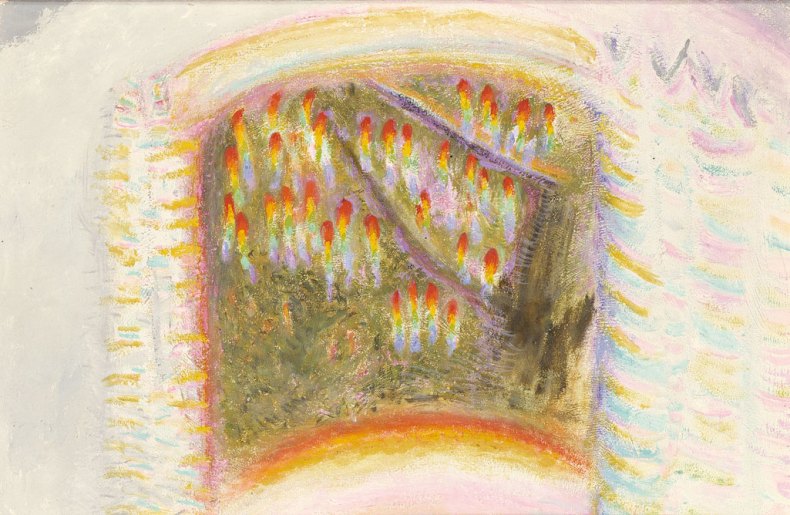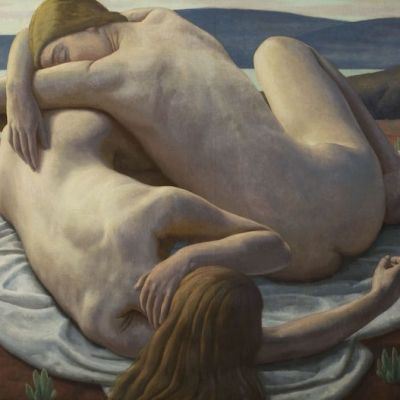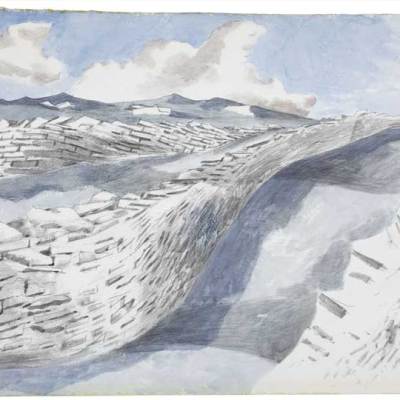In 1923 Winifred Nicholson (1893–1981), with her husband Ben, showed at the Paterson Gallery in London’s Bond Street. Most of the paintings she exhibited had been done in the Ticino, which they had begun visiting every winter for the sake of Ben’s health. While there, he had given her a pot of mughetti – the Italian term for lilies of the valley – wrapped round with plain white tissue paper. Placed on a window sill, the opaque folds of paper caught and refracted the light bouncing off the snow-covered landscape outside. A few pencil marks, still visible in the final painting of the scene, established the bones of the composition but evidently did not delay her for long. For the pot, flowers, and background landscape are painted in an urgent, harsh, almost offhand manner that condenses her idea of what she saw into a powerful, vibrant image. This painting is found near the start of this exhibition, and much that follows stems from this one picture.
Mughetti (c. 1921–22), Winifred Nicholson. © The Trustees of the Estate of Winifred Nicholson

At the Paterson Gallery, it was she, and not Ben, who enjoyed a howling success. It gained her enough money to buy Bankshead, a Cumbrian farmhouse with a sloping garden, offering a panoramic view of the distant fells. She retained this house until the end of her days, unsurprisingly perhaps, for it became woven into her way of life and her art. While staying at Bankshead with the Nicholsons, in 1925, Ivon Hitchens began painting like Winifred, in style and subject matter. It is also said that her father-in-law William Nicholson and Paul Nash both lightened their palettes under her influence. During the early years of the ‘Seven and Five’ exhibiting society, she had a freeing influence on others, including the young sophisticate Christopher Wood, then fresh from Paris and the company of Jean Cocteau. In 1927, the art critic P.G. Konody reckoned that Winifred Nicholson probably had ‘no equal among modern British painters as a colourist of the most exquisite refinement’.
The current exhibition, the largest display of her work since the retrospective mounted by the Tate in 1987, contains several works that, hidden in private collections, have never been publicly shown or illustrated before. (The exhibition travels to the Djanogly Art Gallery, Nottingham, and Falmouth Art Gallery in 2017.) It is a warm and generous display, filling a suite of large galleries in Middlesbrough’s flagship building, and there are numerous moments when the paintings flash with colouristic brilliance. The show undeniably benefits from the contribution made by the artist’s grandson Jovan Nicholson, whose depth of knowledge informs the selection and the catalogue. His notes to each picture emphasise her feeling for place in each painting, and he draws attention to her repeated use of what the artist herself called ‘magenta pink’; even when used sparingly, it is frequently the key to the composition. Yet because flowers are such a persistent ingredient, Jovan has also to admit that it helps to know your kingcups, cotton grass, and yellow flag.
‘Flowers and jewels,’ Winifred Nicholson once wrote, ‘are the only things that express colour fairly consistently.’ It did not matter to her what species the flowers were. She often painted nosegays of wildflowers gathered on walks, but even the smallest flower in her paintings is pricked with intensity. Her aim, as she once said, was ‘to paint pictures that can call down colours, so that a picture can be a lamp in one’s room, not merely a window’. No reproduction can do justice to the intensity she gives to the daffodils and yellow jug in Easter Monday (c. 1950).
Easter Monday (c. 1950), Winifred Nicholson. © The Trustees of the Estate of Winifred Nicholson

She repeatedly positions jugs, jars, glasses or pots of flowers on windowsills, thereby setting up a conversation between the nearby indoor motif and the distant landscape view. Psychologists would no doubt make much of this flow between the inner and outer, but frequently it allows the landscape and flowers to challenge or enhance each other. In The Isle of Man from St Bees (c. 1945) the precise delineation of the flowers is offset by the misty blue of the sea. Elsewhere, in an Irish scene, the wildness in the landscape is countered by the cheerfulness of the sturdy foreground daffodils, whereas in Violas in a Window (late 1940s) the fastness of a hill-bound lake in Snowdonia is affirmed by the foreground violas in a circular pot.
The Isle of Man from St Bees (c. 1945), Winifred Nicholson. © The Trustees of the Estate of Winifred Nicholson

The chronological hang, together with Jovan Nicholson’s long introductory essay, enables the viewer to track sufficient details about Winifred’s life through her art. This is necessary as for her the two were one thing. ‘Winifred taught me much,’ H.S. (Jim) Ede, the maker of Kettle’s Yard at Cambridge, once said, ‘about the fusing of art and daily living.’ After her first visit to the Nicholsons at Bankshead, their early patron, Helen Sutherland, who had arrived in a chauffeur-driven car, expressed sincere admiration for the simplicity of their way of life. Yet the pattern and tenor of Winifred’s life was altered, soon after her third child was born, when Ben shifted his allegiance to Barbara Hepworth and walked out of Bankshead. The repercussions are visible in some of her paintings, and she later admitted to a friend that it was some time before she learnt again about joy.
She moved to the Isle of Wight and other places in Britain, before settling in Paris where she stayed for six years, the longest period she spent living in a city. Here, as is witnessed by the abstract paintings in this show, she took lessons from César Domela, and enjoyed friendships with Arp, Brancusi, Kandinsky, and Mondrian. Warned by a relation of forthcoming war, she moved back to England with her three children in 1938, but returned to Paris later in the year in order to bring Mondrian to the relative safety of London. She suggested that he could make Bankshead his home: its surrounding fields, and Mondrian’s abhorrence of the colour green, made this impossible.
First Prismatic (1976), Winifred Nicholson. © The Trustees of the Estate of Winifred Nicholson

All her life Winifred Nicholson had a great love of rainbows. In biographical details which she supplied for an exhibition catalogue, she once listed rainbows as being among the major events in her life. When given a glass prism in 1976, she was able to look through it and discover rainbow colours in everyday objects and settings. This confirmed her belief that the rainbow prism offered a structure as scientific as the octave is in music. This exhibition ends with a generous selection of her late prism pictures, which further affirm what is made abundantly visible in this show: that colour is one of the surest and most direct ways of expressing joy.
‘Winifred Nicholson: Liberation of Colour’ is at Middlesbrough Institute of Modern Art until 12 February 2017.
From the December 2016 issue of Apollo. Preview and subscribe here.



